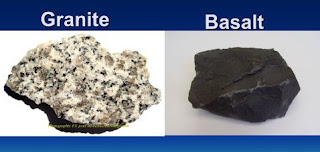 |
| granite vs. basalt |
Like so many freelancers who aren't writing in their native language (based on sentence structure and other clues, we believe she's south Asian), Olivia didn't know which factoids she harvested from some unknown resource were important and which weren't; and she also didn't quite know what a lot of the terminology meant. Let's have a look at some of her more interesting errors and misconceptions, starting with the very first sentence:
"The key difference between basalt and granite is that basalt is mostly occurring on ocean floors, while granite is in the crust of the earth in all continents."
Ummm, no, that's not the "key difference." The most important differences are the same differences used by geologists (as opposed to a freelancing "Graduate in Electronic Engineering") are mineralogy and texture. Olivia managed to tap-dance around both of those parameters with her statement that,
"Basalt is darker and consists of fine-grained minerals such as magnesium and iron. We can name basalt rocks as mafic rocks [sic] as well, just because of this property."
Given that Olivia hadn't mentioned what basalt is "darker" than, the statement is a little confusing. When she baldly stated that magnesium and iron are "minerals," we realized that her definition of the word was rather weak. In fact, basalt is generally composed of minerals that are rich in iron and magnesium. More ignorance ensued when Dawson announced that,
"When considering the nature of these rocks, basalt is basic in nature."
Someone with a rudimentary understanding of geology would know that "basic," in this context, is synonymous with "mafic" – although it's pretty obvious Olivia didn't know this. When she got to granite, her knowledge was equally shallow, beginning with the strangely-worded,
"Granite is lighter in complexion..."
...and continuing in the equally bizarre claim that,
"...granite is acidic in nature. It occurs above the ocean..."
Strange, we thought what's above the ocean is mostly air. Or how about half-assed factoids such as,
- "...rocks that form from magma that has yet not come out of the volcano are termed as intrusive rocks." – No, rocks formed when magma cools at depth are intrusive.
- "...basalt...consists of fine-grained minerals such as magnesium and iron while granite is lighter and consist [sic] of feldspar and quartz." – Magnesium and iron aren't minerals, Olivia. Oh, and granite is rich is silicon and aluminum (or as you'd probably call it, aluminium), hence the term "sialic" in opposition to "mafic."
- "While basalt rocks split along columnar planes, granite rocks give way along horizontal planes." – The notion that granite would "give way along horizontal planes" is news to our geologists, who also point out that only some basalt flows form columnar fractures... oh, and our geometry buff says there's no such thing as "columnar planes," either.
Olivia's research may have led her to facts, but a basic lack of understanding and knowledge about her subject quickly found her deep in the woods of the Dumbass of the Day zone. That's a zone where a large number of DifferenceBetween denizens seem to have lived.
SI - PETROLOGY
No comments:
Post a Comment